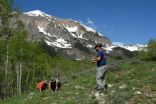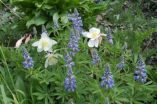(Press-News.org) A unique 39-year study of wildflower blooms in a Colorado Rocky Mountain meadow shows more than two-thirds of alpine flowers have changed their blooming pattern in response to climate change. Not only are half the flowers beginning to bloom weeks earlier, but more than a third are reaching their peak bloom earlier, and others are producing their last blooms later in the year. The bloom season, which used to run from late May to early September, now lasts from late April to late September, according to University of Maryland Biology Professor David Inouye.
The wildflower records, made up of more than two million blooms, show that flowering plants' response to climate change is more complex than previously believed, with different species responding in unexpected ways. The combinations of flower species that bloom together are changing too, with potential impacts on insects and birds. Studies that focus only on the date of flowers' first bloom – as most do – understate these changes, said Inouye, the senior author of a study published online March 17, 2014 in the Proceedings of the National Academy of Sciences.
Phenology, the study of the timing of seasonal events, is crucial to understanding how climate change is affecting plants, animals and the relationships that bind them into natural communities. To answer these questions, phenologists are collecting modern data and poring through old records like amateur naturalists' notebooks.
"Most studies rely on first dates of events like flowering or migration, because they use historical data sets that were not intended as scientific studies," Inouye said. "First flowering is easy to observe. You don't have to take the time to count flowers. So that's often the only information available. It has taken a lot of effort to get the comprehensive insights needed for this analysis, which helps us understand how ecological communities are going to change in the future."
Inouye was not thinking of the effects of a warming climate in 1974, when he began counting flowers on a mountainside 9,500 feet above sea level at the Rocky Mountain Biological Laboratory in Crested Butte, Colo.
"I was a graduate student studying hummingbirds and bumble bees, and I wanted to know what flower nectar resources are available for them, so I started counting flowers," Inouye said.
Others initially took part, but Inouye stuck with it. Eventually he set his own students to the task. By counting blooms in each of 30 plots every other day, up to five months per year, for four decades, the group amassed a data set of more than 2 million flowers they have counted. For this study, University of Arizona doctoral student Paul CaraDonna, University of Maryland postdoctoral research associate Amy Iler and Inouye looked at data on the 60 most common species.
Bloom times are changing fast, the researchers found. The date the first spring flower appears has advanced more than 6 days per decade over the course of the study. The spring peak, when masses of wildflowers burst into bloom, has moved up 5 days per decade. And the last flower of fall occurred about 3 days later every decade.
"The flowering season is about one month longer than it used to be" Iler said, "which is a big change for a mountain ecosystem with a short growing season."
Of all the species that have changed their flowering schedules in some way, only 17% shifted their entire bloom cycle earlier. The rest showed more complicated changes.
"What we show is that first flowering isn't always the best predictor of all the changes we find," CaraDonna said. "It's important to take a closer look in order to understand all the ways that climate change affects these wildflower communities."
The changes are likely to have a strong impact – for better or worse – on pollinating insects and migratory birds. For example, Inouye said, hummingbirds that summer in the Rocky Mountains time their nesting so that their eggs hatch at peak bloom, when there is plenty of flower nectar for hungry chicks. But as the bloom season lengthens, the plants are not producing more flowers. The same number of blooms is spread out over more days, so at peak bloom there may be fewer flowers.
Will there be enough food for the hummingbirds' young? To find out, Inouye plans to fit adult hummingbirds with radio transmitters and study how they interact with this summer's blooms.
INFORMATION:
This research was funded by National Science Foundation grants DEB 75-15422, DEB 78-07784, BSR 81-08387, DEB 94-08382, IBN 98-14508, DEB 02-38331, DEB 09-22080 and DGE-1143953, with additional support from Earthwatch.
College of Computer, Mathematical and Natural Sciences
Contacts:
Heather Dewar, 301-405-9267, hdewar@umd.edu
Abby Robinson, 301-405-5845, abbyr@umd.edu
"Shifts in flowering phenology reshape a subalpine plant community," Paul J. CaraDonna, Amy M. Iler and David W. Inouye, will be published online March 17, 2014 in Proceedings of the National Academy of Sciences.
Rocky Mountain wildflower season lengthens by more than a month
39-year bloom count reveals a series of changes attributed to warmer climate
2014-03-17
ELSE PRESS RELEASES FROM THIS DATE:
U-M scientists slow development of Alzheimer's trademark cell-killing plaques
2014-03-17
ANN ARBOR—University of Michigan researchers have learned how to fix a cellular structure called the Golgi that mysteriously becomes fragmented in all Alzheimer's patients and appears to be a major cause of the disease.
They say that understanding this mechanism helps decode amyloid plaque formation in the brains of Alzheimer's patients—plaques that kills cells and contributes to memory loss and other Alzheimer's symptoms.
The researchers discovered the molecular process behind Golgi fragmentation, and also developed two techniques to 'rescue' the Golgi structure. ...
Bacterial reporters that get the scoop
2014-03-17
It's a jungle in there. In the tightly woven ecosystem of the human gut, trillions of bacteria compete with each other on a daily basis while they sense and react to signals from the immune system, ingested food, and other bacteria.
Problems arise when bad gut bugs overtake friendly ones, or when the immune system is thrown off balance, as in Crohn's disease, celiac disease, and colorectal cancer. Doctors have struggled to diagnose these conditions early and accurately. But now a new engineered strain of E. coli bacteria could deliver status updates from this complex ...
NIH scientists track evolution of a superbug
2014-03-17
Using genome sequencing, National Institutes of Health (NIH) scientists and their colleagues have tracked the evolution of the antibiotic-resistant bacterium Klebsiella pneumoniae sequence type 258 (ST258), an important agent of hospital-acquired infections. While researchers had previously thought that ST258 K. pneumoniae strains spread from a single ancestor, the NIH team showed that the strains arose from at least two different lineages. The investigators also found that the key difference between the two groups lies in the genes involved in production of the bacterium's ...
Stanford makes flexible carbon nanotube circuits more reliable and power efficient
2014-03-17
Engineers would love to create flexible electronic devices, such as e-readers that could be folded to fit into a pocket. One approach they are trying involves designing circuits based on electronic fibers, known as carbon nanotubes (CNTs), instead of rigid silicon chips.
But reliability is essential. Most silicon chips are based on a type of circuit design that allows them to function flawlessly even when the device experiences power fluctuations. However, it is much more challenging to do so with CNT circuits.
Now a team at Stanford has developed a process to create ...
Document addresses improving quality, safety for PCIs performed without on-site backup
2014-03-17
WASHINGTON, DC, and DALLAS (March 17, 2014) – The increasing number of percutaneous coronary interventions (PCIs) being performed at low-volume centers without on-site cardiac surgery backup has driven the need for new safety and quality protocols, according to an expert consensus document released today and written by a committee representing the Society for Cardiovascular Angiography and Interventions (SCAI), the American College of Cardiology Foundation (ACCF) and the American Heart Association (AHA). The document outlines steps hospitals can take to provide the safest ...
Antarctic moss lives after 1,500+ years under ice
2014-03-17
Researchers from the British Antarctic Survey and University of Reading report in the Cell Press journal Current Biology on March 17 that Antarctic mosses can essentially come back to life after 1,500 completely inactive years under the ice.
Prior to this finding, direct regeneration from frozen plant material had been demonstrated after 20 years at most. Beyond that, only microbes had been shown to be capable of revival after so many years on hold.
"These mosses were basically in a very long-term deep freeze," says Peter Convey of the British Antarctic Survey. "This ...
Overpopulation: The transparent elephant in the room causing crucial modern crises
2014-03-17
A review of nearly 200 research articles (~75% published in the last ten years) shows how the issue of population growth is being downplayed and trivialized despite its fundamental role on modern crises related to unemployment, public debt, welfare (e.g., reduced access to food and water or even health and education), extinction of species and climate change. The study suggests that no foreseeable pathways, to fix or ameliorate such crises, are likely without seriously dealing with natality rates by both developed and developing nations.
The paper is written by Camilo ...
Younger men receive faster care for heart attacks, angina compared with women of same age
2014-03-17
A new study indicates that in younger adults experiencing heart attacks and angina, men are more likely to receive faster care compared with women. The study, published in CMAJ (Canadian Medical Association Journal) also found that gender-related factors affected access to care for both men and women.
To understand why sex differences in mortality exist in younger men and women with acute coronary syndrome, researchers included 1123 patients aged 18 to 55 years recruited from 24 centres across Canada, 1 in the United States and 1 in Switzerland. Of the participants, ...
Back to life after 1,500 years
2014-03-17
Researchers from the British Antarctic Survey and Reading University have demonstrated that, after over 1,500 years frozen in Antarctic ice, moss can come back to life and continue to grow. For the first time, this vital part of the ecosystem in both polar regions has been shown to have the ability to survive century to millennial scale ice ages. This provides exciting new insight into the survival of life on Earth.
The team, reporting in Current Biology this week, observed moss regeneration after at least 1,530 years frozen in permafrost. This is the first study to show ...
Fighting antibiotic resistance with 'molecular drill bits'
2014-03-17
DALLAS, March 17, 2014 — In response to drug-resistant "superbugs" that send millions of people to hospitals around the world, scientists are building tiny, "molecular drill bits" that kill bacteria by bursting through their protective cell walls. They presented some of the latest developments on these drill bits, better known to scientists as antimicrobial peptides (AMPs), at the 247th National Meeting & Exposition of the American Chemical Society (ACS), the world's largest scientific society.
The meeting, which features more than 10,000 scientific reports across disciplines ...
LAST 30 PRESS RELEASES:
Manta rays create mobile ecosystems, study finds
Study: Mixed results in using lipoic acid to treat progressive multiple sclerosis
Norbert Holtkamp appointed director of Fermi National Accelerator Laboratory
New agentic AI platform accelerates advanced optics design
Biologists discover neurons use physical signals — not electricity — to stabilize communication
Researchers discover that a hormone can access the brain by hitchhiking
University of Oklahoma researcher awarded funding to pursue AI-powered material design
Exploring how the visual system recovers following injury
Support for parents with infants at pediatric check-ups leads to better reading and math skills in elementary school
Kids’ behavioral health is a growing share of family health costs
Day & night: Cancer disrupts the brain’s natural rhythm
COVID-19 vaccination significantly reduces risk to pregnant women and baby
The role of vaccination in maternal and perinatal outcomes associated with COVID-19 in pregnancy
Mayo Clinic smartwatch system helps parents shorten and defuse children's severe tantrums early
Behavioral health spending spikes to 40% of all children’s health expenditures, nearly doubling in a decade
Digital cognitive behavioral treatment for generalized anxiety disorder
Expenditures for pediatric behavioral health care over time and estimated family financial burden
Air conditioning in nursing homes and mortality during extreme heat
The Alps to lose a record number of glaciers in the next decade
What makes a good proton conductor?
New science reporting guide published for journalists in Bulgaria
New international study reveals major survival gaps among children with cancer
New science reporting guide published for journalists in Turkey
Scientists develop a smarter mRNA therapy that knows which cells to target
Neuroanatomy-informed brain–machine hybrid intelligence for robust acoustic target detection
Eight SwRI hydrogen projects funded by ENERGYWERX
The Lundquist Institute and its start-up company Vitalex Biosciences Announces Strategic Advancement of Second-Generation fungal Vaccine VXV-01 through Phase 1 Trials under $40 Million Competitive Con
Fine particles in pollution are associated with early signs of autoimmune disease
Review article | Towards a Global Ground-Based Earth Observatory (GGBEO): Leveraging existing systems and networks
Penn and UMich create world’s smallest programmable, autonomous robots
[Press-News.org] Rocky Mountain wildflower season lengthens by more than a month39-year bloom count reveals a series of changes attributed to warmer climate





